MBA506: Negotiation and Conflict Management Report - Analysis
VerifiedAdded on 2022/09/14
|15
|2169
|17
Report
AI Summary
This report analyzes a negotiation scenario for the sale of a commercial asset, specifically focusing on the student's role as an agent representing a company. It begins by exploring the student's preferred thinking style (anarchic) and scope (external) and assesses their suitability for the negotiation. The report then details the client's and the other party's BATNA (Best Alternative To a Negotiated Agreement) and reservation values, and identifies the ZOPA (Zone Of Possible Agreement). The student discusses the negotiation process, highlighting arguments and offers made, including a price range for the asset. The report analyzes the negotiation strategy, emphasizing the importance of flexibility and collaboration. The student recommends a specific strategy, focusing on the price offered and the potential for a successful deal. The report also includes references to relevant negotiation theories and concepts.

RUNNING HEAD: NEGOTIATION
Negotiation
Name of the student
Name of the university
Author Note
Negotiation
Name of the student
Name of the university
Author Note
Paraphrase This Document
Need a fresh take? Get an instant paraphrase of this document with our AI Paraphraser
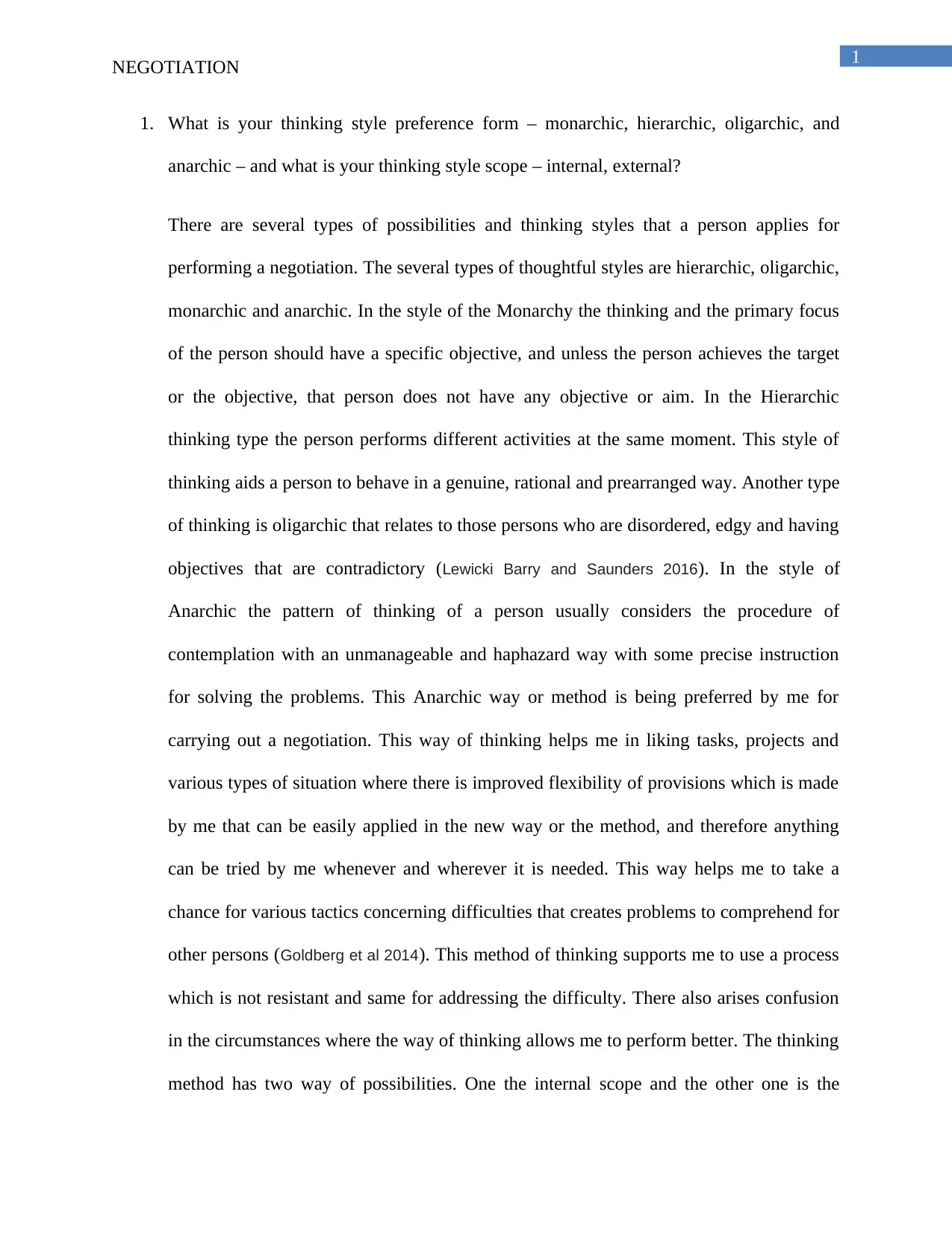
1
NEGOTIATION
1. What is your thinking style preference form – monarchic, hierarchic, oligarchic, and
anarchic – and what is your thinking style scope – internal, external?
There are several types of possibilities and thinking styles that a person applies for
performing a negotiation. The several types of thoughtful styles are hierarchic, oligarchic,
monarchic and anarchic. In the style of the Monarchy the thinking and the primary focus
of the person should have a specific objective, and unless the person achieves the target
or the objective, that person does not have any objective or aim. In the Hierarchic
thinking type the person performs different activities at the same moment. This style of
thinking aids a person to behave in a genuine, rational and prearranged way. Another type
of thinking is oligarchic that relates to those persons who are disordered, edgy and having
objectives that are contradictory (Lewicki Barry and Saunders 2016). In the style of
Anarchic the pattern of thinking of a person usually considers the procedure of
contemplation with an unmanageable and haphazard way with some precise instruction
for solving the problems. This Anarchic way or method is being preferred by me for
carrying out a negotiation. This way of thinking helps me in liking tasks, projects and
various types of situation where there is improved flexibility of provisions which is made
by me that can be easily applied in the new way or the method, and therefore anything
can be tried by me whenever and wherever it is needed. This way helps me to take a
chance for various tactics concerning difficulties that creates problems to comprehend for
other persons (Goldberg et al 2014). This method of thinking supports me to use a process
which is not resistant and same for addressing the difficulty. There also arises confusion
in the circumstances where the way of thinking allows me to perform better. The thinking
method has two way of possibilities. One the internal scope and the other one is the
NEGOTIATION
1. What is your thinking style preference form – monarchic, hierarchic, oligarchic, and
anarchic – and what is your thinking style scope – internal, external?
There are several types of possibilities and thinking styles that a person applies for
performing a negotiation. The several types of thoughtful styles are hierarchic, oligarchic,
monarchic and anarchic. In the style of the Monarchy the thinking and the primary focus
of the person should have a specific objective, and unless the person achieves the target
or the objective, that person does not have any objective or aim. In the Hierarchic
thinking type the person performs different activities at the same moment. This style of
thinking aids a person to behave in a genuine, rational and prearranged way. Another type
of thinking is oligarchic that relates to those persons who are disordered, edgy and having
objectives that are contradictory (Lewicki Barry and Saunders 2016). In the style of
Anarchic the pattern of thinking of a person usually considers the procedure of
contemplation with an unmanageable and haphazard way with some precise instruction
for solving the problems. This Anarchic way or method is being preferred by me for
carrying out a negotiation. This way of thinking helps me in liking tasks, projects and
various types of situation where there is improved flexibility of provisions which is made
by me that can be easily applied in the new way or the method, and therefore anything
can be tried by me whenever and wherever it is needed. This way helps me to take a
chance for various tactics concerning difficulties that creates problems to comprehend for
other persons (Goldberg et al 2014). This method of thinking supports me to use a process
which is not resistant and same for addressing the difficulty. There also arises confusion
in the circumstances where the way of thinking allows me to perform better. The thinking
method has two way of possibilities. One the internal scope and the other one is the
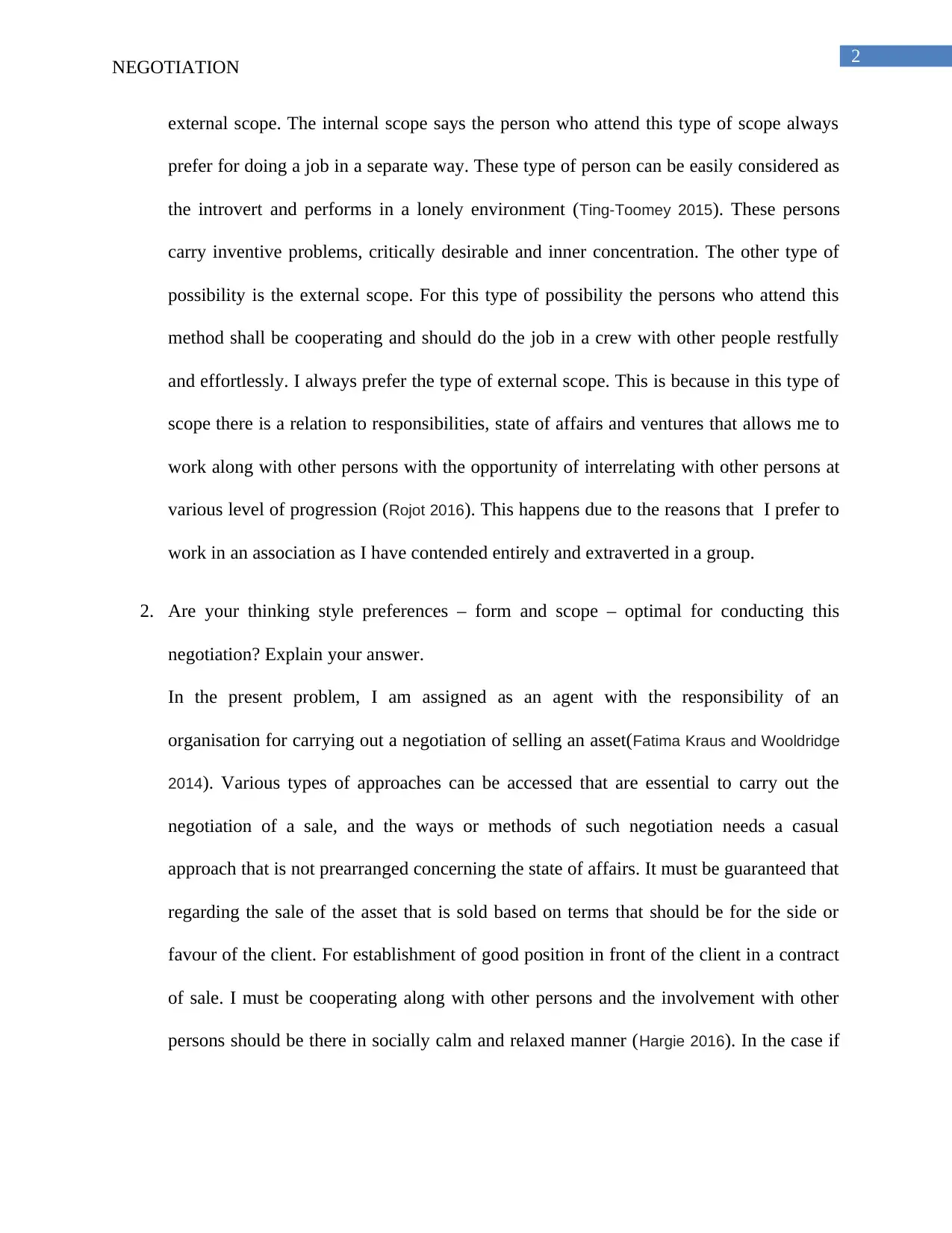
2
NEGOTIATION
external scope. The internal scope says the person who attend this type of scope always
prefer for doing a job in a separate way. These type of person can be easily considered as
the introvert and performs in a lonely environment (Ting‐Toomey 2015). These persons
carry inventive problems, critically desirable and inner concentration. The other type of
possibility is the external scope. For this type of possibility the persons who attend this
method shall be cooperating and should do the job in a crew with other people restfully
and effortlessly. I always prefer the type of external scope. This is because in this type of
scope there is a relation to responsibilities, state of affairs and ventures that allows me to
work along with other persons with the opportunity of interrelating with other persons at
various level of progression (Rojot 2016). This happens due to the reasons that I prefer to
work in an association as I have contended entirely and extraverted in a group.
2. Are your thinking style preferences – form and scope – optimal for conducting this
negotiation? Explain your answer.
In the present problem, I am assigned as an agent with the responsibility of an
organisation for carrying out a negotiation of selling an asset(Fatima Kraus and Wooldridge
2014). Various types of approaches can be accessed that are essential to carry out the
negotiation of a sale, and the ways or methods of such negotiation needs a casual
approach that is not prearranged concerning the state of affairs. It must be guaranteed that
regarding the sale of the asset that is sold based on terms that should be for the side or
favour of the client. For establishment of good position in front of the client in a contract
of sale. I must be cooperating along with other persons and the involvement with other
persons should be there in socially calm and relaxed manner (Hargie 2016). In the case if
NEGOTIATION
external scope. The internal scope says the person who attend this type of scope always
prefer for doing a job in a separate way. These type of person can be easily considered as
the introvert and performs in a lonely environment (Ting‐Toomey 2015). These persons
carry inventive problems, critically desirable and inner concentration. The other type of
possibility is the external scope. For this type of possibility the persons who attend this
method shall be cooperating and should do the job in a crew with other people restfully
and effortlessly. I always prefer the type of external scope. This is because in this type of
scope there is a relation to responsibilities, state of affairs and ventures that allows me to
work along with other persons with the opportunity of interrelating with other persons at
various level of progression (Rojot 2016). This happens due to the reasons that I prefer to
work in an association as I have contended entirely and extraverted in a group.
2. Are your thinking style preferences – form and scope – optimal for conducting this
negotiation? Explain your answer.
In the present problem, I am assigned as an agent with the responsibility of an
organisation for carrying out a negotiation of selling an asset(Fatima Kraus and Wooldridge
2014). Various types of approaches can be accessed that are essential to carry out the
negotiation of a sale, and the ways or methods of such negotiation needs a casual
approach that is not prearranged concerning the state of affairs. It must be guaranteed that
regarding the sale of the asset that is sold based on terms that should be for the side or
favour of the client. For establishment of good position in front of the client in a contract
of sale. I must be cooperating along with other persons and the involvement with other
persons should be there in socially calm and relaxed manner (Hargie 2016). In the case if
⊘ This is a preview!⊘
Do you want full access?
Subscribe today to unlock all pages.

Trusted by 1+ million students worldwide
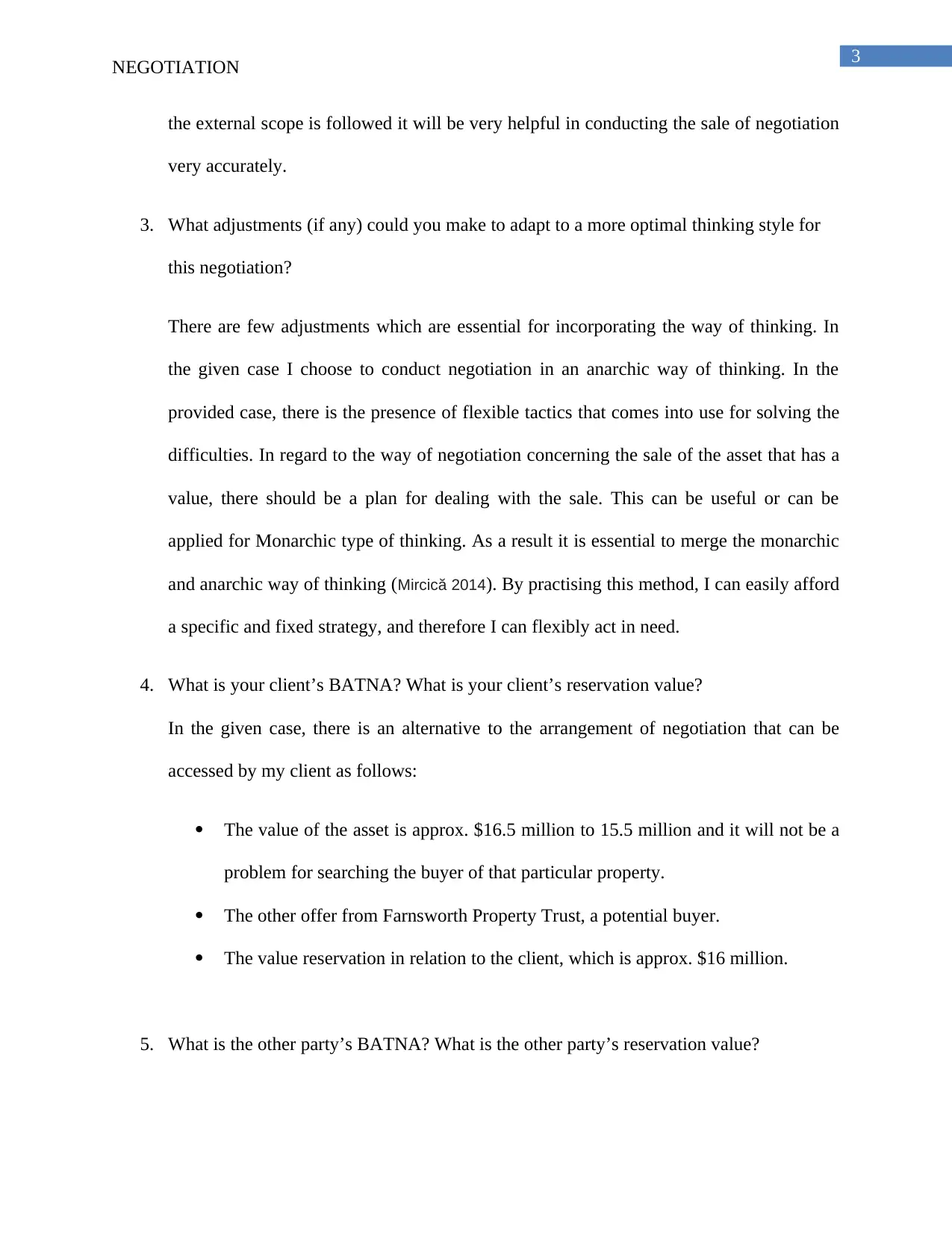
3
NEGOTIATION
the external scope is followed it will be very helpful in conducting the sale of negotiation
very accurately.
3. What adjustments (if any) could you make to adapt to a more optimal thinking style for
this negotiation?
There are few adjustments which are essential for incorporating the way of thinking. In
the given case I choose to conduct negotiation in an anarchic way of thinking. In the
provided case, there is the presence of flexible tactics that comes into use for solving the
difficulties. In regard to the way of negotiation concerning the sale of the asset that has a
value, there should be a plan for dealing with the sale. This can be useful or can be
applied for Monarchic type of thinking. As a result it is essential to merge the monarchic
and anarchic way of thinking (Mircică 2014). By practising this method, I can easily afford
a specific and fixed strategy, and therefore I can flexibly act in need.
4. What is your client’s BATNA? What is your client’s reservation value?
In the given case, there is an alternative to the arrangement of negotiation that can be
accessed by my client as follows:
The value of the asset is approx. $16.5 million to 15.5 million and it will not be a
problem for searching the buyer of that particular property.
The other offer from Farnsworth Property Trust, a potential buyer.
The value reservation in relation to the client, which is approx. $16 million.
5. What is the other party’s BATNA? What is the other party’s reservation value?
NEGOTIATION
the external scope is followed it will be very helpful in conducting the sale of negotiation
very accurately.
3. What adjustments (if any) could you make to adapt to a more optimal thinking style for
this negotiation?
There are few adjustments which are essential for incorporating the way of thinking. In
the given case I choose to conduct negotiation in an anarchic way of thinking. In the
provided case, there is the presence of flexible tactics that comes into use for solving the
difficulties. In regard to the way of negotiation concerning the sale of the asset that has a
value, there should be a plan for dealing with the sale. This can be useful or can be
applied for Monarchic type of thinking. As a result it is essential to merge the monarchic
and anarchic way of thinking (Mircică 2014). By practising this method, I can easily afford
a specific and fixed strategy, and therefore I can flexibly act in need.
4. What is your client’s BATNA? What is your client’s reservation value?
In the given case, there is an alternative to the arrangement of negotiation that can be
accessed by my client as follows:
The value of the asset is approx. $16.5 million to 15.5 million and it will not be a
problem for searching the buyer of that particular property.
The other offer from Farnsworth Property Trust, a potential buyer.
The value reservation in relation to the client, which is approx. $16 million.
5. What is the other party’s BATNA? What is the other party’s reservation value?
Paraphrase This Document
Need a fresh take? Get an instant paraphrase of this document with our AI Paraphraser
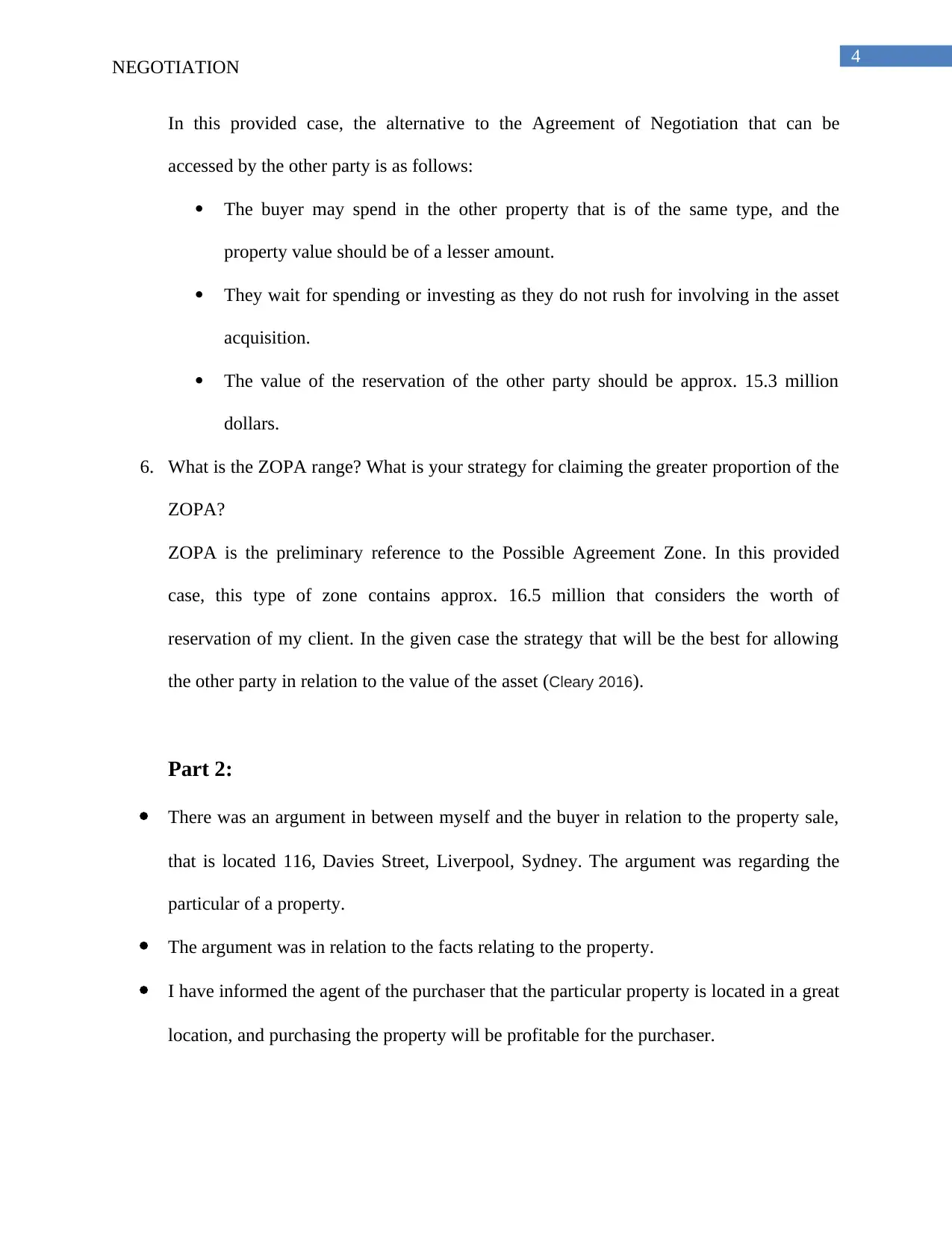
4
NEGOTIATION
In this provided case, the alternative to the Agreement of Negotiation that can be
accessed by the other party is as follows:
The buyer may spend in the other property that is of the same type, and the
property value should be of a lesser amount.
They wait for spending or investing as they do not rush for involving in the asset
acquisition.
The value of the reservation of the other party should be approx. 15.3 million
dollars.
6. What is the ZOPA range? What is your strategy for claiming the greater proportion of the
ZOPA?
ZOPA is the preliminary reference to the Possible Agreement Zone. In this provided
case, this type of zone contains approx. 16.5 million that considers the worth of
reservation of my client. In the given case the strategy that will be the best for allowing
the other party in relation to the value of the asset (Cleary 2016).
Part 2:
There was an argument in between myself and the buyer in relation to the property sale,
that is located 116, Davies Street, Liverpool, Sydney. The argument was regarding the
particular of a property.
The argument was in relation to the facts relating to the property.
I have informed the agent of the purchaser that the particular property is located in a great
location, and purchasing the property will be profitable for the purchaser.
NEGOTIATION
In this provided case, the alternative to the Agreement of Negotiation that can be
accessed by the other party is as follows:
The buyer may spend in the other property that is of the same type, and the
property value should be of a lesser amount.
They wait for spending or investing as they do not rush for involving in the asset
acquisition.
The value of the reservation of the other party should be approx. 15.3 million
dollars.
6. What is the ZOPA range? What is your strategy for claiming the greater proportion of the
ZOPA?
ZOPA is the preliminary reference to the Possible Agreement Zone. In this provided
case, this type of zone contains approx. 16.5 million that considers the worth of
reservation of my client. In the given case the strategy that will be the best for allowing
the other party in relation to the value of the asset (Cleary 2016).
Part 2:
There was an argument in between myself and the buyer in relation to the property sale,
that is located 116, Davies Street, Liverpool, Sydney. The argument was regarding the
particular of a property.
The argument was in relation to the facts relating to the property.
I have informed the agent of the purchaser that the particular property is located in a great
location, and purchasing the property will be profitable for the purchaser.
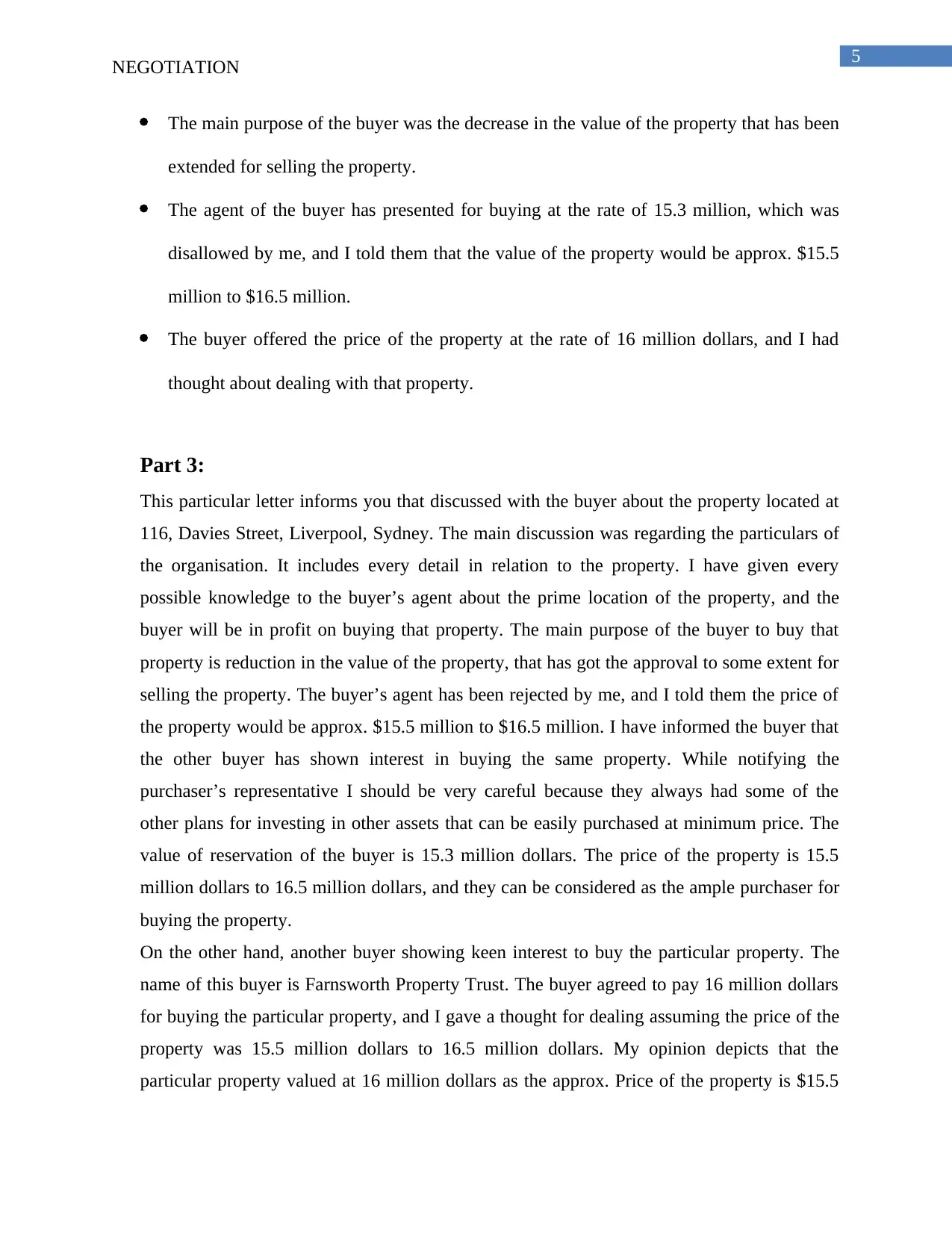
5
NEGOTIATION
The main purpose of the buyer was the decrease in the value of the property that has been
extended for selling the property.
The agent of the buyer has presented for buying at the rate of 15.3 million, which was
disallowed by me, and I told them that the value of the property would be approx. $15.5
million to $16.5 million.
The buyer offered the price of the property at the rate of 16 million dollars, and I had
thought about dealing with that property.
Part 3:
This particular letter informs you that discussed with the buyer about the property located at
116, Davies Street, Liverpool, Sydney. The main discussion was regarding the particulars of
the organisation. It includes every detail in relation to the property. I have given every
possible knowledge to the buyer’s agent about the prime location of the property, and the
buyer will be in profit on buying that property. The main purpose of the buyer to buy that
property is reduction in the value of the property, that has got the approval to some extent for
selling the property. The buyer’s agent has been rejected by me, and I told them the price of
the property would be approx. $15.5 million to $16.5 million. I have informed the buyer that
the other buyer has shown interest in buying the same property. While notifying the
purchaser’s representative I should be very careful because they always had some of the
other plans for investing in other assets that can be easily purchased at minimum price. The
value of reservation of the buyer is 15.3 million dollars. The price of the property is 15.5
million dollars to 16.5 million dollars, and they can be considered as the ample purchaser for
buying the property.
On the other hand, another buyer showing keen interest to buy the particular property. The
name of this buyer is Farnsworth Property Trust. The buyer agreed to pay 16 million dollars
for buying the particular property, and I gave a thought for dealing assuming the price of the
property was 15.5 million dollars to 16.5 million dollars. My opinion depicts that the
particular property valued at 16 million dollars as the approx. Price of the property is $15.5
NEGOTIATION
The main purpose of the buyer was the decrease in the value of the property that has been
extended for selling the property.
The agent of the buyer has presented for buying at the rate of 15.3 million, which was
disallowed by me, and I told them that the value of the property would be approx. $15.5
million to $16.5 million.
The buyer offered the price of the property at the rate of 16 million dollars, and I had
thought about dealing with that property.
Part 3:
This particular letter informs you that discussed with the buyer about the property located at
116, Davies Street, Liverpool, Sydney. The main discussion was regarding the particulars of
the organisation. It includes every detail in relation to the property. I have given every
possible knowledge to the buyer’s agent about the prime location of the property, and the
buyer will be in profit on buying that property. The main purpose of the buyer to buy that
property is reduction in the value of the property, that has got the approval to some extent for
selling the property. The buyer’s agent has been rejected by me, and I told them the price of
the property would be approx. $15.5 million to $16.5 million. I have informed the buyer that
the other buyer has shown interest in buying the same property. While notifying the
purchaser’s representative I should be very careful because they always had some of the
other plans for investing in other assets that can be easily purchased at minimum price. The
value of reservation of the buyer is 15.3 million dollars. The price of the property is 15.5
million dollars to 16.5 million dollars, and they can be considered as the ample purchaser for
buying the property.
On the other hand, another buyer showing keen interest to buy the particular property. The
name of this buyer is Farnsworth Property Trust. The buyer agreed to pay 16 million dollars
for buying the particular property, and I gave a thought for dealing assuming the price of the
property was 15.5 million dollars to 16.5 million dollars. My opinion depicts that the
particular property valued at 16 million dollars as the approx. Price of the property is $15.5
⊘ This is a preview!⊘
Do you want full access?
Subscribe today to unlock all pages.

Trusted by 1+ million students worldwide

6
NEGOTIATION
million dollars to $16.5 million dollars. It should be remembered that every purchaser thinks
of an alternative that is available to the buyer. As per the ZOPA that defined earlier in this
context the actual zonal price of the property should be approx. 16 million dollars. Therefore
in the provided case the better strategy is to sell the possession at the value that is offered by
the buyer which can be around 16 million dollars and it could not be less than the said value.
NEGOTIATION
million dollars to $16.5 million dollars. It should be remembered that every purchaser thinks
of an alternative that is available to the buyer. As per the ZOPA that defined earlier in this
context the actual zonal price of the property should be approx. 16 million dollars. Therefore
in the provided case the better strategy is to sell the possession at the value that is offered by
the buyer which can be around 16 million dollars and it could not be less than the said value.
Paraphrase This Document
Need a fresh take? Get an instant paraphrase of this document with our AI Paraphraser
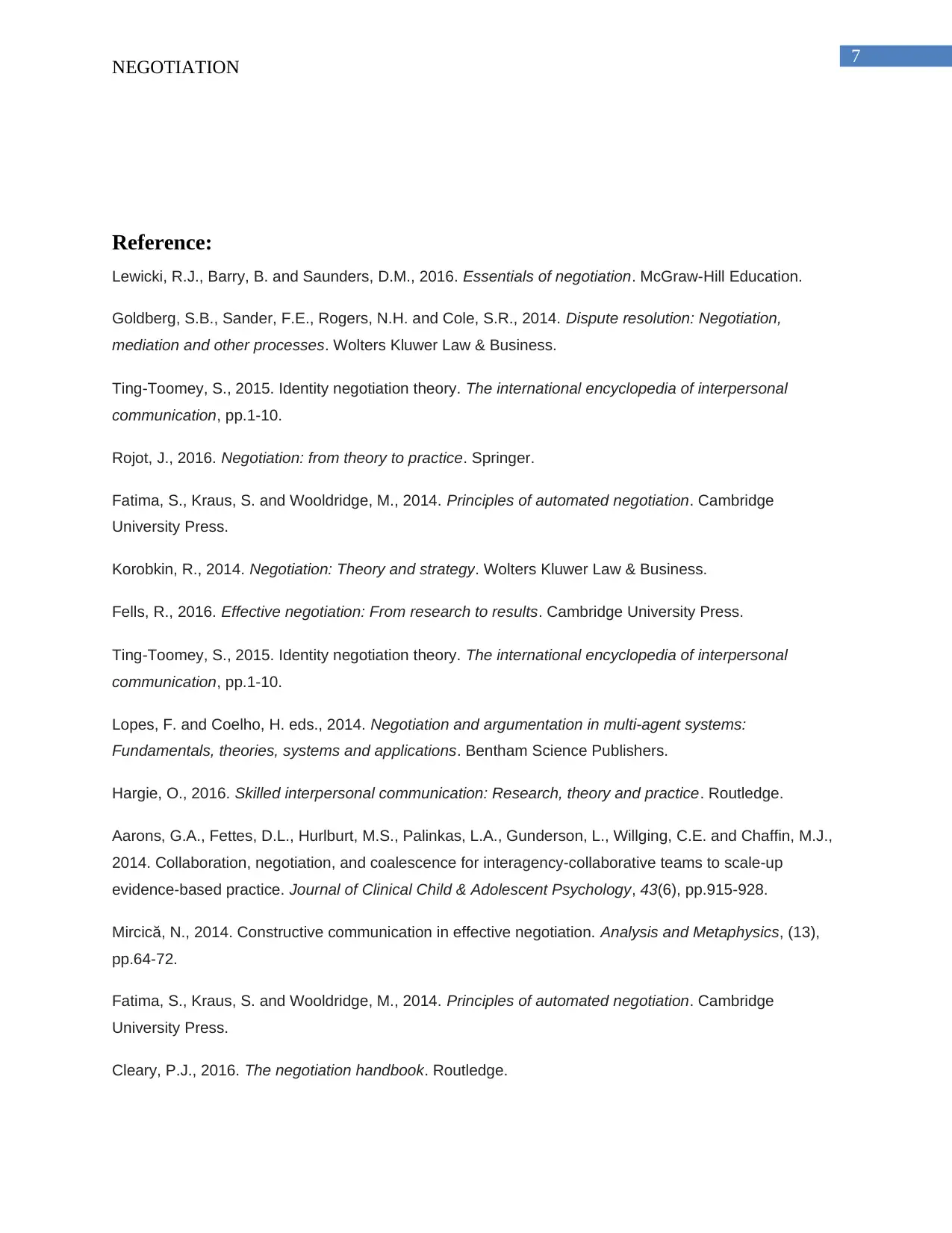
7
NEGOTIATION
Reference:
Lewicki, R.J., Barry, B. and Saunders, D.M., 2016. Essentials of negotiation. McGraw-Hill Education.
Goldberg, S.B., Sander, F.E., Rogers, N.H. and Cole, S.R., 2014. Dispute resolution: Negotiation,
mediation and other processes. Wolters Kluwer Law & Business.
Ting‐Toomey, S., 2015. Identity negotiation theory. The international encyclopedia of interpersonal
communication, pp.1-10.
Rojot, J., 2016. Negotiation: from theory to practice. Springer.
Fatima, S., Kraus, S. and Wooldridge, M., 2014. Principles of automated negotiation. Cambridge
University Press.
Korobkin, R., 2014. Negotiation: Theory and strategy. Wolters Kluwer Law & Business.
Fells, R., 2016. Effective negotiation: From research to results. Cambridge University Press.
Ting‐Toomey, S., 2015. Identity negotiation theory. The international encyclopedia of interpersonal
communication, pp.1-10.
Lopes, F. and Coelho, H. eds., 2014. Negotiation and argumentation in multi-agent systems:
Fundamentals, theories, systems and applications. Bentham Science Publishers.
Hargie, O., 2016. Skilled interpersonal communication: Research, theory and practice. Routledge.
Aarons, G.A., Fettes, D.L., Hurlburt, M.S., Palinkas, L.A., Gunderson, L., Willging, C.E. and Chaffin, M.J.,
2014. Collaboration, negotiation, and coalescence for interagency-collaborative teams to scale-up
evidence-based practice. Journal of Clinical Child & Adolescent Psychology, 43(6), pp.915-928.
Mircică, N., 2014. Constructive communication in effective negotiation. Analysis and Metaphysics, (13),
pp.64-72.
Fatima, S., Kraus, S. and Wooldridge, M., 2014. Principles of automated negotiation. Cambridge
University Press.
Cleary, P.J., 2016. The negotiation handbook. Routledge.
NEGOTIATION
Reference:
Lewicki, R.J., Barry, B. and Saunders, D.M., 2016. Essentials of negotiation. McGraw-Hill Education.
Goldberg, S.B., Sander, F.E., Rogers, N.H. and Cole, S.R., 2014. Dispute resolution: Negotiation,
mediation and other processes. Wolters Kluwer Law & Business.
Ting‐Toomey, S., 2015. Identity negotiation theory. The international encyclopedia of interpersonal
communication, pp.1-10.
Rojot, J., 2016. Negotiation: from theory to practice. Springer.
Fatima, S., Kraus, S. and Wooldridge, M., 2014. Principles of automated negotiation. Cambridge
University Press.
Korobkin, R., 2014. Negotiation: Theory and strategy. Wolters Kluwer Law & Business.
Fells, R., 2016. Effective negotiation: From research to results. Cambridge University Press.
Ting‐Toomey, S., 2015. Identity negotiation theory. The international encyclopedia of interpersonal
communication, pp.1-10.
Lopes, F. and Coelho, H. eds., 2014. Negotiation and argumentation in multi-agent systems:
Fundamentals, theories, systems and applications. Bentham Science Publishers.
Hargie, O., 2016. Skilled interpersonal communication: Research, theory and practice. Routledge.
Aarons, G.A., Fettes, D.L., Hurlburt, M.S., Palinkas, L.A., Gunderson, L., Willging, C.E. and Chaffin, M.J.,
2014. Collaboration, negotiation, and coalescence for interagency-collaborative teams to scale-up
evidence-based practice. Journal of Clinical Child & Adolescent Psychology, 43(6), pp.915-928.
Mircică, N., 2014. Constructive communication in effective negotiation. Analysis and Metaphysics, (13),
pp.64-72.
Fatima, S., Kraus, S. and Wooldridge, M., 2014. Principles of automated negotiation. Cambridge
University Press.
Cleary, P.J., 2016. The negotiation handbook. Routledge.

8
NEGOTIATION
Messina, F., Pappalardo, G., Santoro, C., Rosaci, D. and Sarné, G.M., 2014, June. An agent based
negotiation protocol for cloud service level agreements. In 2014 IEEE 23rd International WETICE
Conference (pp. 161-166). IEEE.
NEGOTIATION
Messina, F., Pappalardo, G., Santoro, C., Rosaci, D. and Sarné, G.M., 2014, June. An agent based
negotiation protocol for cloud service level agreements. In 2014 IEEE 23rd International WETICE
Conference (pp. 161-166). IEEE.
⊘ This is a preview!⊘
Do you want full access?
Subscribe today to unlock all pages.

Trusted by 1+ million students worldwide

9
NEGOTIATION
NEGOTIATION
Paraphrase This Document
Need a fresh take? Get an instant paraphrase of this document with our AI Paraphraser

10
NEGOTIATION
NEGOTIATION

11
NEGOTIATION
NEGOTIATION
⊘ This is a preview!⊘
Do you want full access?
Subscribe today to unlock all pages.

Trusted by 1+ million students worldwide
1 out of 15
Related Documents
Your All-in-One AI-Powered Toolkit for Academic Success.
+13062052269
info@desklib.com
Available 24*7 on WhatsApp / Email
![[object Object]](/_next/static/media/star-bottom.7253800d.svg)
Unlock your academic potential
Copyright © 2020–2025 A2Z Services. All Rights Reserved. Developed and managed by ZUCOL.





